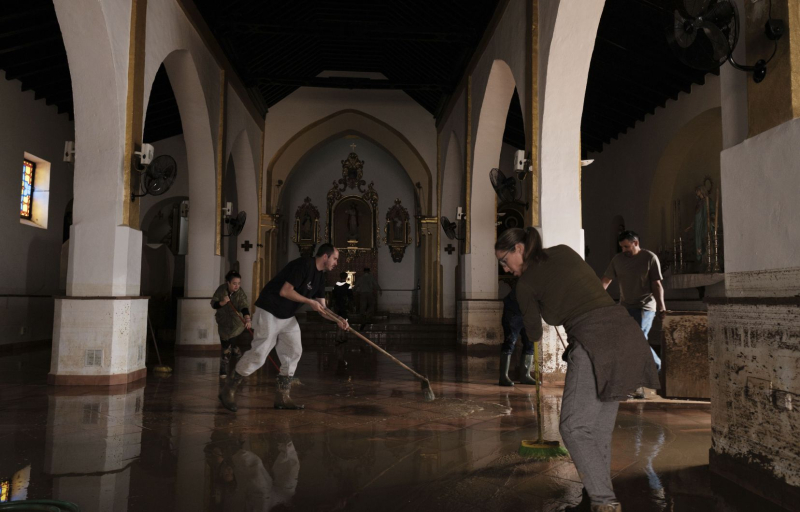
Photo: Gregorio Marrero Associated Press Several people clean a church in Benagarmosa, in the Malaga region, which was flooded on Thursday.
José Jordan – Agence France-Presse and Valentin Bontemps – Agence France-Presse respectively in Valencia and Madrid
Posted at 10:57 a.m.
- Europe
“The worst is over”: the Spanish Meteorological Agency lifted its red alert for bad weather in southern and eastern Spain on Thursday, after a night marked by heavy rainfall, which did not cause any new casualties.
AEMET downgraded its alert to “orange” level for the Andalusian province of Malaga (south) and the Valencia region (east), where memories of the floods that killed at least 224 people two weeks ago had made those affected fear the worst.
The public agency had placed these two regions on red alert on Wednesday evening, the maximum possible level, due to an “extreme” risk of flooding linked to the presence of a new “cold drop”, an isolated depression at high altitude quite common in autumn on the Spanish Mediterranean coast.
“Avoid travel. Rivers may overflow and floods may occur,” it warned. A message widely relayed by the authorities, anxious to avoid a new disaster scenario, fifteen days after the tragic storms that have brought mourning to the south-east of the country.
According to AEMET, torrential rains did indeed fall during the night from Wednesday to Thursday, with accumulations of 110 litres of water per square metre (110 millimetres) in Alcudia de Veo, in the hinterland of Valencia, and 88 l per m3 (88 mm) in Chiva, a village already hit by the floods at the end of October.
Read also
- The coastline near Valencia on red alert, two weeks after the deadly floods
- The death toll from the floods in Spain exceeds 200
- Tens of thousands of Spaniards take to the streets to express their anger at the management of the floods
But these heavy rainfalls caused little damage, even if streets were flooded and roads were occasionally closed, both in Andalusia and in the Valencia region. Above all, they have not caused any new victims, according to the authorities.
“Prevention is better than cure”
Due to this new bad weather, the regional government of Valencia announced on Wednesday a series of preventive measures in a total of 163 municipalities, with school closures and traffic restrictions.
“The night was complicated. […] We have never seen so much rain,” testified Jordi Mayor, mayor of Cullera, on public television TVE. In this seaside town located near Valencia, the streets were still “impassable” on Thursday morning, but the damage was limited.
In Malaga, where air traffic was severely disrupted on Wednesday, more than 4,200 people were evacuated as a precaution, mainly near the Guadalhorce, a river threatened with overflowing. School was also suspended for nearly 500,000 schoolchildren.
“I know that this has created problems for many families,” but “prevention is better than cure,” justified the president of the Andalusian region, Juanma Moreno, on Thursday, specifying that the evacuated people would probably not be able to return home before Friday.
For Jess Neumann, professor of hydrology at the University of Reading, in the United Kingdom, “the speed of the evacuations probably saved many lives.” This “shows how quickly it is possible and necessary to act when alerts are issued,” he judged in an analysis note.
Beginning of a return to normal
On Thursday, however, a beginning of a return to normal was visible in the areas concerned. In Malaga, the Billie Jean King Cup tennis tournament was able to begin after a 24-hour postponement due to rain.
In the Valencia region, restrictions on the movement of private cars have also been lifted, while rail traffic with Madrid resumed late in the morning, for the first time in two weeks.
This return to normal is, however, more complicated in the areas ravaged by the floods of 29 October, where clearing and infrastructure repair work continues, as does the search for the 16 people still missing.
The latter is concentrated “on a strip 200 kilometres long and 60 kilometres wide”, particularly near the mouth of the Turia River, where the bodies could have been carried by the floods, said Rosa Touris, spokesperson for CECOPI, the emergency committee set up after the floods.
Due to the new rains, the hearing of the president of the region, Carlos Mazón, who was supposed to explain his management of the disaster to the regional parliament on Thursday, has been postponed until Friday.
The conservative leader, who has been the subject of strong criticism for his management of the floods of October 29, could announce a reshuffle of his government on this occasion, according to Spanish media.

